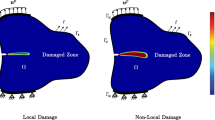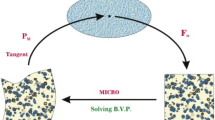Abstract
A simple, yet accurate, procedure is developed for computing stress intensity factors via finite element analyses of cracked, elastic composites. Attention is focused on bodies with piece-wise constant, isotropic, elastic properties which are deforming in plane strain. The crack-tip is taken to be wholly enclosed in a single homogeneous region; thus, the well-known square-root singular field prevails. The superposition procedure, in effect, regularizes the original singular problem by deducing the error incurred in numerically computing the non-regular (singular) part. The method is illustrated by considering a few test problems.
Résumé
On a développé une procédure simple, encore que précise, pour le calcul par élémente finis des facteurs d'intensité de contraintes dans des composites élastiques fissurés. On a concentré son attention sur des corps présentant, à l'instar de pièces réelles, des propriétés isotropes, élastiques et constantes, et déformés en état plan de déformation. On suppose que l'extrémité de la fissure est complètement enrobée d'une région homogène simple, ce qui permet de faire prévaloir la relation singulière bien connue de la racine carrée du champ. En fait, une procédure de superposition régularise le problème singulier initial, en déduisant l'erreur résultant d'un calcul numérique d'une portion non régulière. On illustre la méthode en prenant en considération quelques problèmes d'essais.
Similar content being viewed by others
References
R.H. Gallagher, in Numerical Methods in Fracture Mechanics, Proceedings 1st International Conference, University College Swansea (1978) 1–25.
Y. Yamamoto and N. Tokuda, International Journal for Numerical Methods in Engineering 6 (1973) 427–439.
L.S.D. Morley, Philosophical Transactions of the Royal Society (London) A275 (1973) 463–488.
G.B. Sinclair and D. Mullan, International Journal for Numerical Methods in Engineering 18 (1982) 1587–1600.
J.R. Rice, in Fracture, An Advanced Treatise (ed.H. Liebowitz) Academic Press, New York, 2 (1968) 191–311.
G.B. Sinclair, M. Okajima and J.H. Griffin, International Journal for Numerical Methods in Engineering 20 (1984) 999–10008.
W.C. Carpenter, International Journal of Fracture 24 (1984) 45–58.
M.L. Williams, Journal of Applied Mechanics 19 (1952) 526–528.
M. Isida, International Journal of Fracture 7 (1971) 301–316.
P.S. Steif, “A Semi-infinite Crack Partially Penetrating A Circular Inclusion” (under review).
Author information
Authors and Affiliations
Rights and permissions
About this article
Cite this article
Steif, P.S. A superposition procedure for computing stress intensity factors in cracked elastic composites. Int J Fract 29, 223–233 (1985). https://doi.org/10.1007/BF00125472
Received:
Revised:
Issue Date:
DOI: https://doi.org/10.1007/BF00125472




